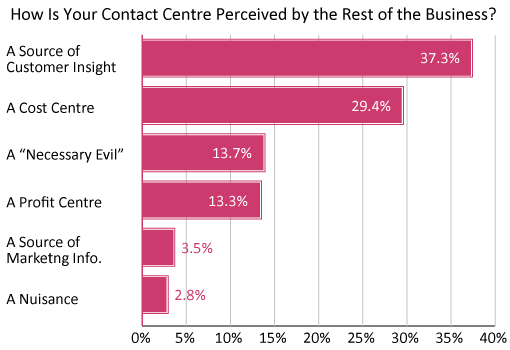Liz Doig of Wordtree suggests ways for call centre teams to become more central to corporate strategy.
Why Is Customer Service Seen as a Cost?
“Customer-centricity” is something that corporations across the world are striving to achieve and maintain. It’s a philosophy of structuring the entire business around the needs and wants of customers. And it can be transformational.
The products and services offered by customer-centric companies are more likely to please, because they’ve been built with customers in mind.
The products and services offered by customer-centric companies are more likely to please, because they’ve been built with customers in mind. Their communications are more likely to be understood. And their processes are less likely to be a pain for the people who are paying for them.
In a customer-centric organization, everything is constantly tweaked and updated to be more in line with what customers need and want. So far, so sensible.
But here’s where it goes a bit wonky. Where do corporations go to find out what customers want and need? Do they hit up their customer services teams and say: “You guys have your finger on the pulse here – could you please tell us what you know?”
You’d think they would. But they don’t. Or at least they rarely do.
Instead, marketing and customer experience teams hire agencies, consultants and researchers to tell them who their customers are, what they do and what they want.
In the meantime, the customer services function – and the contact centres within it – are often only viewed as a cost centre. Or in other words, a part of the business that eats away at profit rather than contributing to it.

This chart has been taken from the report: What Contact Centres Are Doing Right Now – How Do You Compare? (2019 Edition)
In fact, according to Call Centre Helper research from 2019, just short of 30% of organizations are said to think of the contact centre as a “cost centre”, while an additional 13.7% believe it to be a “necessary evil” – as highlighted in the graph above.
As situations go, it’s a bit nuts.
So, Why Doesn’t Head Office Look to Contact Centres for Customer Insights?
There are a number of reasons for the disconnect between head office and contact centres – and they can be different in every organization.
One factor can be geographical distance, because call centres can be sited a long way from head office – and out of sight can mean out of mind.
Sometimes there’s less respect for “softer” communications skills – so contact centres can be seen as places where nice-people-who-don’t-know-so-much-about-business work.
Also, because call centres are places that have to focus on minute detail, measuring and assessing myriad metrics, the professionals in them sometimes struggle to speak in the big-picture terms that head office decision-makers prefer.

Because call centres are places that have to focus on minute detail… the professionals in them sometimes struggle to speak in the big-picture terms that head office decision-makers prefer.
But this disconnect costs businesses in a number of ways. For a start, it means a valuable source of customer insight is being ignored (while consultants are being paid for).
Then there’s the indirect cost of not taking every opportunity to get every single member of a corporation pulling in the same direction and contributing in every way possible to achieving an organization’s business objectives.
So how can a contact centre begin to position itself more strategically in its organization?
Changing the way your organization thinks about its contact centres isn’t going to happen overnight. But there are some positive easy steps you can take to get the ball rolling.
1. Start Joining the Dots
What are your company’s goals? What is it investing in right now? How does it want to be seen in the wider world? And how could the information that flows into your contact centres every day help to make these things happen?
For example, if your company is investing heavily in innovation – it would be really useful for your colleagues in product development to know that you’ve had 80 calls this month, asking if you’re going to launch an app that can integrate banking.
It would be really useful for your colleagues in product development to know that you’ve had 80 calls this month, asking if you’re going to launch an app that can integrate banking.
If you want customer services and the contact centre to be seen in a more strategic light, it starts with joining these kinds of dots.
2. Ask for Meetings With Head Office Decision-Makers
Corporate leaders are generally very keen to hear new ideas and to get members of their teams to make suggestions.
So find out who your head – or director – of marketing, customer experience or product development is and give them a call or drop them a line.
I was thinking it would be a good idea for us to talk and to explore ways we could channel this information back to you.
Say: “We’re sitting on a gold mine of customer insight over here. I was thinking it would be a good idea for us to talk and to explore ways we could channel this information back to you.”
These colleagues are not going to refuse a meeting like this. They may be a little nonplussed – because in a lot of organizations, the call centre doesn’t interact with the rest of the organization in this way. And they may bring colleagues with them. But they’re very unlikely to say no.
You can discuss trends you’ve been picking up on. You can talk about resource – who’s got budget to pay for what. And you can suggest piloting an approach for sharing customer information with the rest of the business.
3. Systematically Gather Customer Insight Data
A lot of contact centres are already very good at being the canary in the coal mine.
For example, if there is a catastrophic failure in service, the contact centre is usually the first to be alerted to it. And there may already be a highly effective cascade system in place to deal with this kind of event.
However, the fact that 100 customers this week asked if you had those flip-flops in pink rather than khaki – or that the usual 50-ish people didn’t understand that particular clause in their insurance policy – might slip under the radar.

Either create a mechanism for teams to record needs/wants/loves/frustrations manually – or use voice recognition and AI to highlight frequent questions and phrases.
So either create a mechanism for teams to record needs/wants/loves/frustrations manually – or use voice recognition and AI to highlight frequent questions and phrases.
The key is to do it as part of business as usual. Then formalize the information you gather into reports – and share it with the contacts you’re making across the business.
For more on finding key insights from customer data, read our article: 9 Ways to Analyse Customer Data
4. Raise Awareness of the Work of the Contact Centre
Are there any easy ways of sharing your work and insights from the call centre with the rest of the business? For example, the intranet? Or could you create your own newsletter?
Give the whole organization short, sharp, regular updates about insights from customers services each week:
- Did you know… 10% of contacts this week were from overseas?
- Did you know… five people called us this week because they were lonely?
- Did you know… more than 100 people contacted us to say thank you?
Also, share ways in which people in the contact centre are living your brand, helping the organization to achieve its objectives – and making the business look great.
5. Bring the Rest of the Business Into the Contact Centre
If your organization isn’t already doing this, suggest that everyone in the business spends at least a day a year listening in to calls in the contact centre.
There isn’t a professional on the planet whose game would not be bettered by actually listening to customers – even for a short space of time.
Just as importantly, rotating other functions through contact centres helps to integrate customer services into the business and close any gaps.
Final Thoughts
The closer a function is to the decision-making, the more highly it’s regarded and the more resource it tends to receive. These alone are great reasons to want to make the value of the contact centre more evident to head office.

Liz Doig
On top of that, there is the satisfaction of being able to contribute to the direction your company is moving in, by acting as a vital bridge between customer insight and corporate decision-making.
Because we all know that contact centres – and the teams who drive them – are critical to a business’s success. And it’s about time the rest of the organization woke up to this too.
Thanks to Liz Doig at Wordtree for sharing this article with us.
For more expert advice from Liz, be sure to read some of her other great articles, which can be found by clicking any of the following links:
- “Sorry for the Inconvenience”– How to Offer a Genuine Apology
- Customer Service Emails and Letters: How to Review and Improve Your Templates
- The Best Ways to Communicate With Upset Customers
Author: Liz Doig
Published On: 20th May 2020 - Last modified: 10th Jun 2024
Read more about - Call Centre Management, Customer Service, Liz Doig, Voice of the Customer





































